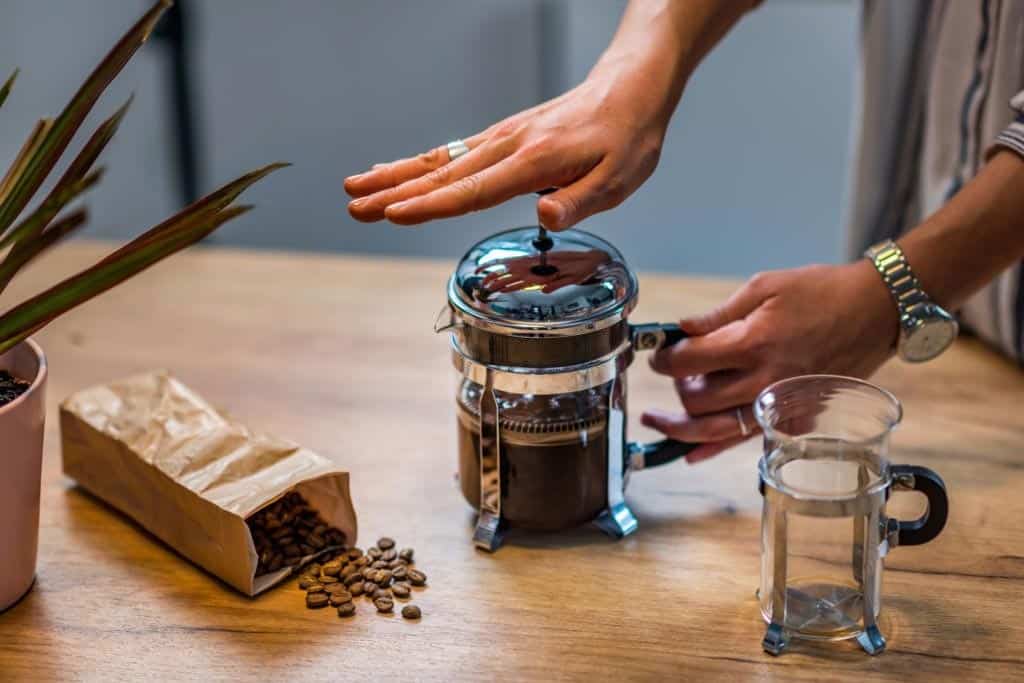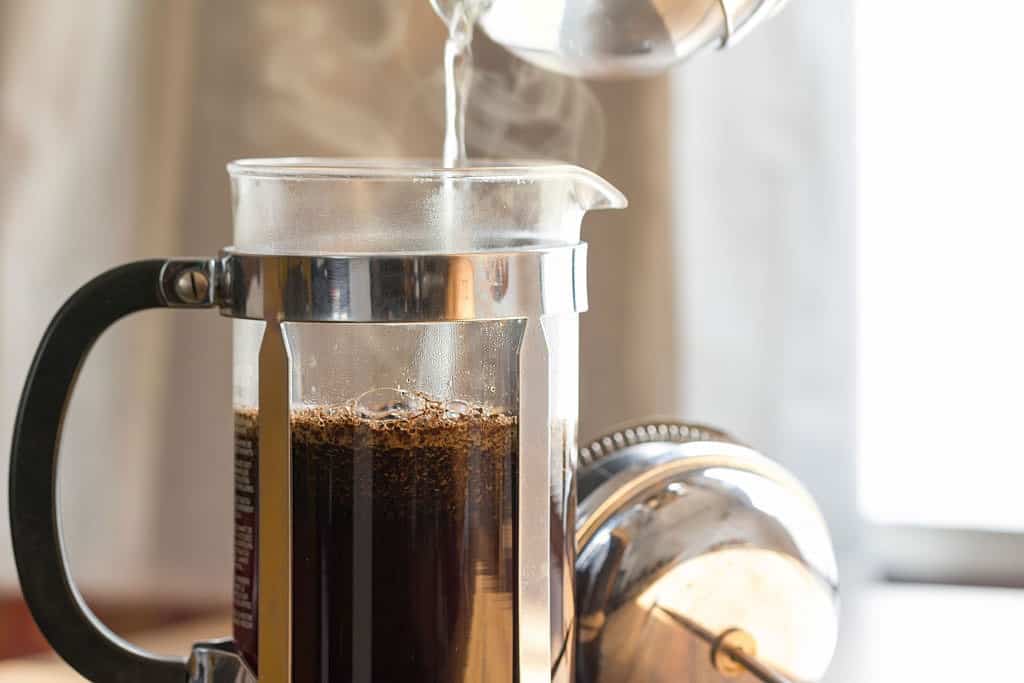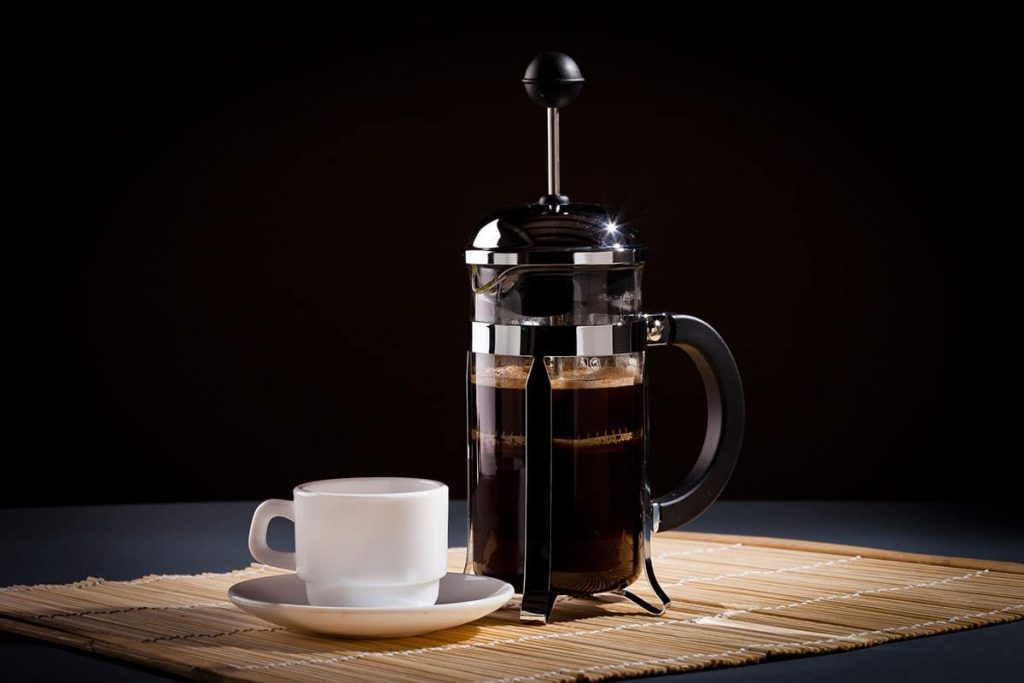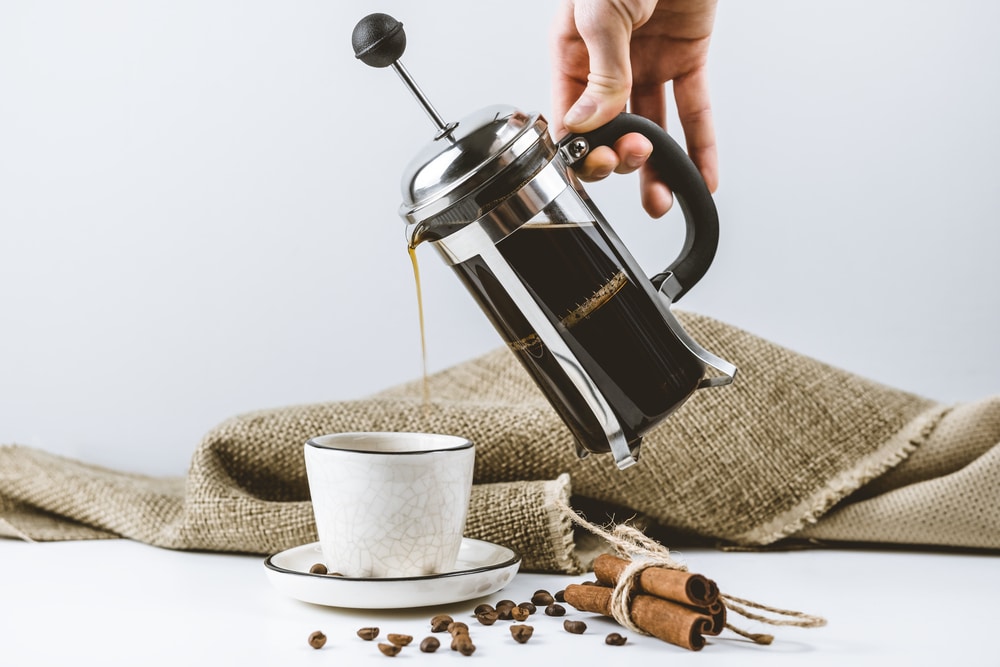How to Make Espresso with a French Press
 Table Of Contents
Table Of ContentsAh, the beloved espresso: a strong kick of high-quality caffeine made by shooting high-pressured water through delicious coffee grinds. Why not satisfy this craving by learning how to make espresso with a French press at home?
Espresso machines can be quite pricey to purchase and maintain, and even a budget-friendly espresso machine could be unnecessary if you don’t drink espresso often enough. This doesn’t mean you can’t enjoy a strong brew from time to time when you crave the rich flavors.
While there is no way to create a true espresso without using an espresso machine, you can come fairly close. There are many methods to make a strong brew of coffee similar to the cherished espresso. One of these brew methods is to make espresso with a French press.
How Does an Espresso Machine and a French Press Work?
To create a true espresso, you need to use an actual espresso machine, but why? To understand the answer, you will need to know how this machine works. Learning how a French press works will also help you see why it can mimic the espresso taste.
An Espresso Machine
An espresso machine works by forcing high-pressured water through ground coffee beans and a filter. The water should be near boiling point to produce a thick cup of coffee with highly concentrated flavors.
There are a few different ways that espresso machines create pressure, including a piston, air pump, steam, or pump. Pretty simple, right? Well, the key point to note is the pressure because this is what makes an espresso.
A French Press
A French press is a common coffee tool found in coffee lovers’ homes. It is a simple way to brew coffee without needing a lot of skill or time. The press is made up of a glass chamber with a plunge filter that fits inside it.

The French press brews the coffee inside the chamber and the plunger is used to filter out the coffee grounds. This plunging movement also helps create some pressure in the chamber. Remember: Pressure is necessary for a strong espresso!
The plunge motion won’t be able to create the same pressure you would get from an espresso machine, but it can help create a very strong brew of coffee.
What You Will Need
You will need to gather a few supplies before brewing up a strong coffee with your trusty French press:
- A French press
- High-quality coffee beans (or espresso beans)
- A burr grinder that grinds to the right size for a French press
- A kitchen scale
- A spoon
A French press: Naturally, this item is pretty essential for this method. You can use any French press, and these can be found at most coffee stores and online shops such as Amazon.
Coffee beans: When choosing your coffee beans, you should consider two things. Firstly, your own taste preferences, and secondly, the right type of coffee beans for espresso.
If you have a favorite brand of coffee that you love and use as your go-to, then you can find out if they have an espresso bean variation or whole dark roasted coffee beans. Choosing these beans will add strong flavors to your coffee and mimic the espresso taste.
A burr grinder: Despite your French press requiring ground beans to brew your coffee, buying whole beans will ensure you are making the freshest brew you can. As soon as the coffee beans are ground, they start to oxidate. This process releases the key flavors of the beans.
Grinding your own beans at home means you can brew the coffee straight away to enjoy the full-bodied flavors of your coffee beans. A burr grinder is also an important tool to have. Burr grinders are key to keeping your coffee grounds consistent and ensuring optimal flavors.
A kitchen scale: While you can measure out your coffee using a spoon, a kitchen scale will give you an accurate amount of coffee for your brew. Once you have brewed this coffee a few times, you will be able to scoop the right amount in without too much thought.
A spoon: The spoon is simply used to stir the water in the French press to ensure the coffee grounds don’t all stick together.

How to Make Espresso with a French Press: The Method
Creating a French press espresso is not only a good way to enjoy extra strong coffee, but it will also help you become more familiar with how coffee brewing works. There are so many ways to improve the taste and consistency of your coffee by tweaking brew times, grind consistencies, and other factors.
If you haven’t used a French press to make espresso-style coffee before, know that you’ll need to make some tweaks to the way you’d .make a regular brewed coffee with it. We have here a guide on how to do it, but as with any other coffee brewing procedure, you can tweak the amounts and times to suit your preferences.
Step 1: The Grind
Start by grinding up the right amount of beans. You will need about 1 oz of ground coffee for every cup of water you use. This is a good starting point, but you should adjust it as necessary to your taste preference.
Use a burr grinder to grind the beans to a fine to medium grind. This part is a bit tricky, and it will likely take a few attempts to get the grind size just right. Espresso requires a very fine grind for the coffee to extract correctly.
However, a French press uses a coarse grind because the brew time is generally longer, and you don’t want any coffee grinds to pass through the mesh into your coffee. Try to balance these two requirements to get the right grind for flavor extraction.
Step 2: Heat the Press and the Water
Start boiling your water while you warm up the French press. You can do that by running warm water over the glass. This will prevent the cold glass from cracking and the espresso temperature from dropping.
You want your hot water to be just about 195 degrees Fahrenheit before you add it to the coffee. You can also add your coffee to the French press while the water is heating up.
Step 3: Let the Coffee Bloom
This step is crucial to producing the rich espresso taste as you want the coffee to begin releasing the natural oils and gases before brewing. This process will prevent the coffee from tasting bitter, and it gives your coffee that signature smoothness.
You can do this by splashing a small amount of the heated water over the coffee grounds. You want the grounds to be damp, not soaked, and you should leave it like this for about 30 seconds.
Step 4: Brew the Coffee
Once the grounds have been blooming for 30 seconds, you can add your hot water to the French press. Use enough water for how many espresso shots you are making. Remember to use 1 oz of coffee grounds per cup of water as required for rich flavors.
Once you have added the water, give the mix a quick stir with the spoon. This will ensure the coffee grounds don’t stick together as this will interfere with the release of the rich coffee flavors.
Step 5: Let it Steep
Now place the lid on the press with the plunger all the way up. You need to give the coffee time to brew before plunging. The lid will help keep the heat inside since temperature is important for bold espresso flavors to release.
You can leave the coffee to steep for roughly four minutes; however, you should play around with the timing for a weaker or stronger tasting espresso. Leave it for another minute or two if you want extra strong coffee.
If the result of your steeping time is a bitter coffee, then you should shorten the brew time when you try again.
Step 6: Plunge
When you start plunging, remember there is quite a bit of pressure in the chamber, so you don’t want to plunge down too hard and fast. Apply even pressure as you press down the plunger and stop halfway.
Lift the plunger back to the top, and then repeat this halfway plunge two more times if you want some extra crema on top. Finally, press the plunger right down to the bottom of the French press.
Side note: The coffee crema is the foamy layer on top of the coffee and will only be present when using quality coffee beans.
Step 7: Pour and Enjoy

All that is left is for you to pour the French press espresso into your demitasse and enjoy it. This step is important to do right after plunging. If you leave the coffee to sit, it will continue extracting coffee. This will lead to a bitter-tasting drink.
If your drink comes out gritty, this is a result of the coffee grounds being too fine. You can try a coarser grind next time or add another filter by pouring the coffee through a thin tea cloth. This will filter out any extra grounds that have slipped through.
FAQs
Can you make espresso in a French press?
Technically, there is no way to make a true espresso without using an espresso machine. The espresso is created with finely ground beans and high-pressure water. The forcing of the water through the beans is what makes this type of coffee unique.
You can, however, create an espresso-style coffee using some coffee equipment you may have at home. You can try various methods, including the French press, a moka pot, or an AeroPress. These methods can mimic the pressure used in espresso machines and, along with strong coffee beans, make a drink very similar to a rich and creamy espresso.
Does a French press brew contain more caffeine than an espresso?
The amount of caffeine found in a French press vs an espresso machine will depend on how much coffee you are drinking. Espresso is essentially a small concentrated shot of coffee that is high in caffeine. However, the shot is fairly small.
French press coffee is also fairly high in caffeine, especially if you are aiming to create an espresso-style drink in your press. This may mean you end up drinking more and are thus consuming more caffeine than you would in a single shot of espresso.
What type of coffee beans are best for a French press?
The French press brewing method works well with a medium to a dark roasted coffee bean. This is because the brewing method helps extract the bold coffee flavors while leaving behind most of the bitterness that is usually associated with a dark roast bean.
Can I reuse grounds in my French press?
If you would like to, you can reuse your grounds in your French press, but you should note a few things first. Most of the coffee flavors will have been extracted during your first steep, and your second batch will lack the bold flavors of your first brew.
The grounds that are left sitting in the French press will also start to become bitter, so if you would like to reuse the grounds, you should do this within 15 minutes of your first batch to reduce the bitterness.
You can reuse these grounds, but for a rich and bold cup of coffee, you may as well just use some fresh, new grounds for your next batch.
Your Espresso-Style Drink Awaits
While you can never make an authentic shot of espresso using anything but the correct machine, you can still create a brew that comes very close. This French press method is a great way to experiment with coffee flavors and brewing techniques.
Make sure you have your grinder ready, and be sure to have a look at some quality coffee beans to try out in your next French press brew.
Owen is a writer and editor at Caffe Streets who considers himself a coffee fanatic. He spends his time researching and testing different coffee beans and brewing methods and sharing what he learns with others.





